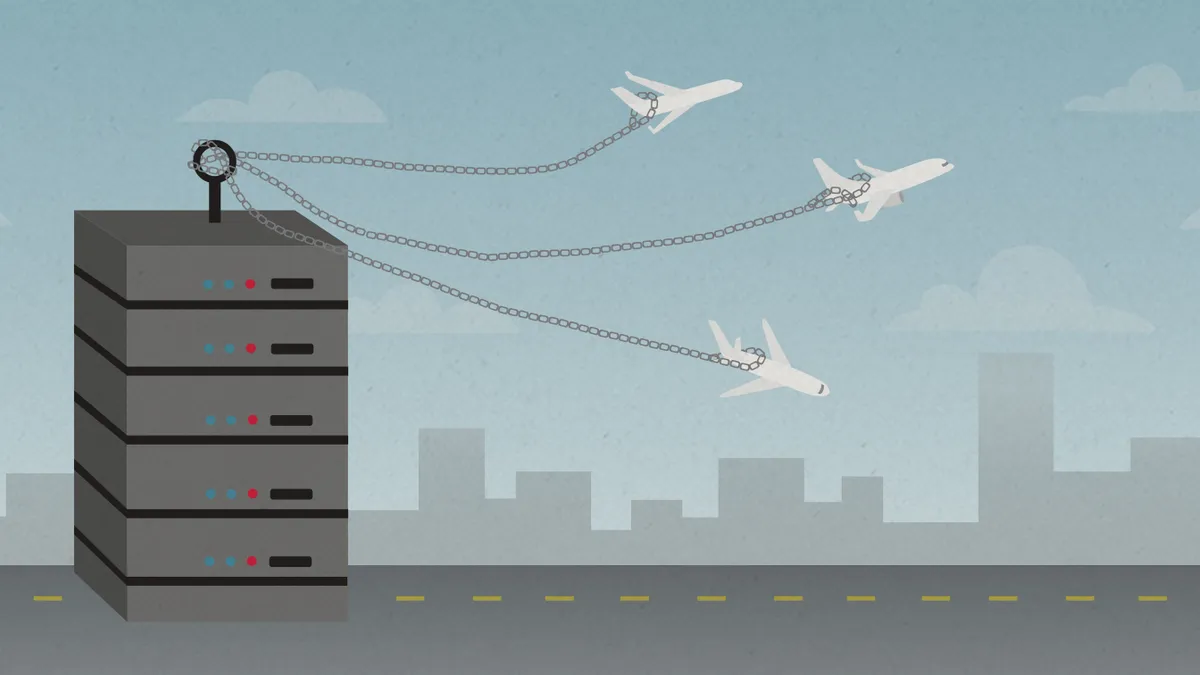This is the first in a series looking into the technology challenges the airline industry is facing and how it is looking to innovate. The next installment will look into promising new platforms, services and products the airline industry is testing.
In August, Delta airlines passed a milestone it would probably just as soon forget: the one-year mark since a systemwide computer failure led to 2,000 cancelled flights over several days — all of it caused by a power outage in Atlanta.
The debacle turned into a sort of poster child for an airline industry that can't seem to keep its IT backbone straight. But the outage was just one of the many foibles doggedly tracked by news website Quartz, which has documented airline hiccups, big and small, since late 2015.
Is all this hand-wringing fact or fiction? Is the airline industry really that far behind other industries when it comes to IT? Absolutely, say industry analysts. The reasons are many, but a key one which has led to systemic problems is simply that IT has not received enough attention, according to airline and travel industry analyst Henry Harteveldt.
"Until recently, airline CIOs never had the respect they deserve from their CEOs," he said, "because CEOs hadn’t been interested in IT. CIOs might be part of the executive leadership but often are not part of inner most circles [at airlines]."
Underinvested, overwhelmed
In addition to, or perhaps because of, the low placement of IT among airline priorities, the industry gave it little financial support.
On average, airlines spend around 2.7% of revenue on IT, while other industry averages range from 4% to more than 6%. The disparity is largely due to the relatively thin margins with which airlines operate. However, airlines also run exceptionally complex operations, which only amplifies their need for more resilient operations.
Harteveldt compares running an airline to playing "a multi-dimensional game of chess" in which even small missteps can trigger a cascading chain of reactions.
Airlines depend on hundreds or even thousands of software applications, many written in different languages —and some many decades old. "For too long, airlines were running technology that was developed when Kennedy and Johnson were running United States," said Harteveldt.
One can argue that if a given software platform works, it doesn't need fixing. But the more disparate languages and protocols an organization runs, the more it needs robust middleware and interfaces to ensure uptime, creating more complexity.
Consumers have been given more avenues to communicate directly with airlines. From online booking to mobile-based boarding passes and in-app purchases to text messaging flight information, the number of touch points and possible failures — not to mention interfaces that need robust cybersecurity protections — have only grown.
"Not all airlines have thought through disaster scenario planning," said Harteveldt. "Or [in some cases] they outsourced IT to third parties — but if someone trips over a plug that whole data center is thrown off."
Mark Jaggers, a research director with Gartner, said outages cause significant damage even if they're not catastrophic. Disaster recovery processes are designed to respond to large scale events, like when an entire data center goes offline. Recovery, which could include setting up an alternate data center, can take days.
Due to a likely lag time, disaster recovery is not evoked in response to smaller problems. But what about when those small problems escalate into systemwide outages? Now the airline has just extended its downtime and amplified its customers' frustration.
Changing the flight pattern
Fortunately, things are changing. Airline CEOs "are starting to understand that they are running flying technology companies," said Harteveldt.
He traces the origins of this enlightenment back to 2008, when, in response to the financial crisis, airlines started to charge separately for services that were previously tightly integrated with ticketing, such as in-flight food and entertainment or baggage handling. "When they began to unbundle, [airlines] took the puzzle apart, but putting the pieces back together was hard," said Harteveldt.
On top of that, consolidation within the industry and alliances between airlines have only added to the complexities of ticketing and reservations. On a given trip, a ticket is issued by multiple airlines to passengers whose preferences, special needs and frequent flier benefits must be tracked by all parties managing reservations.
Add a mechanical problem or weather delay and passengers may have to be shifted to a different airplane with a different number of seats, and a cascading set of consequences arises when disparate software platforms — reservations/ticketing, loyalty programs, mobile apps — need to sync. Add to this an oversold flight and the tyranny of angry customers turning to social media and problems are quickly amplified.
In an attempt to find less turbulent air, the industry is beginning to elevate the role of the CIO and trying to spend more on IT. "CEOs recognize that they can't starve IT anymore," said Harteveldt. Delta, American Airlines and Alaska Airlines are among the carriers spending more on IT. In fact, Alaska Airlines quadrupled its IT spending since 2012.
Airlines are also beginning to look outside of endemic airline IT platforms and providers to improve everything from customer relationship management to maintenance and operations. They are making their IT architectures more resilient to small disturbances in order to avert more catastrophic failures. "We're seeing a concerted effort to have lower recovery time," said Jagger.



















